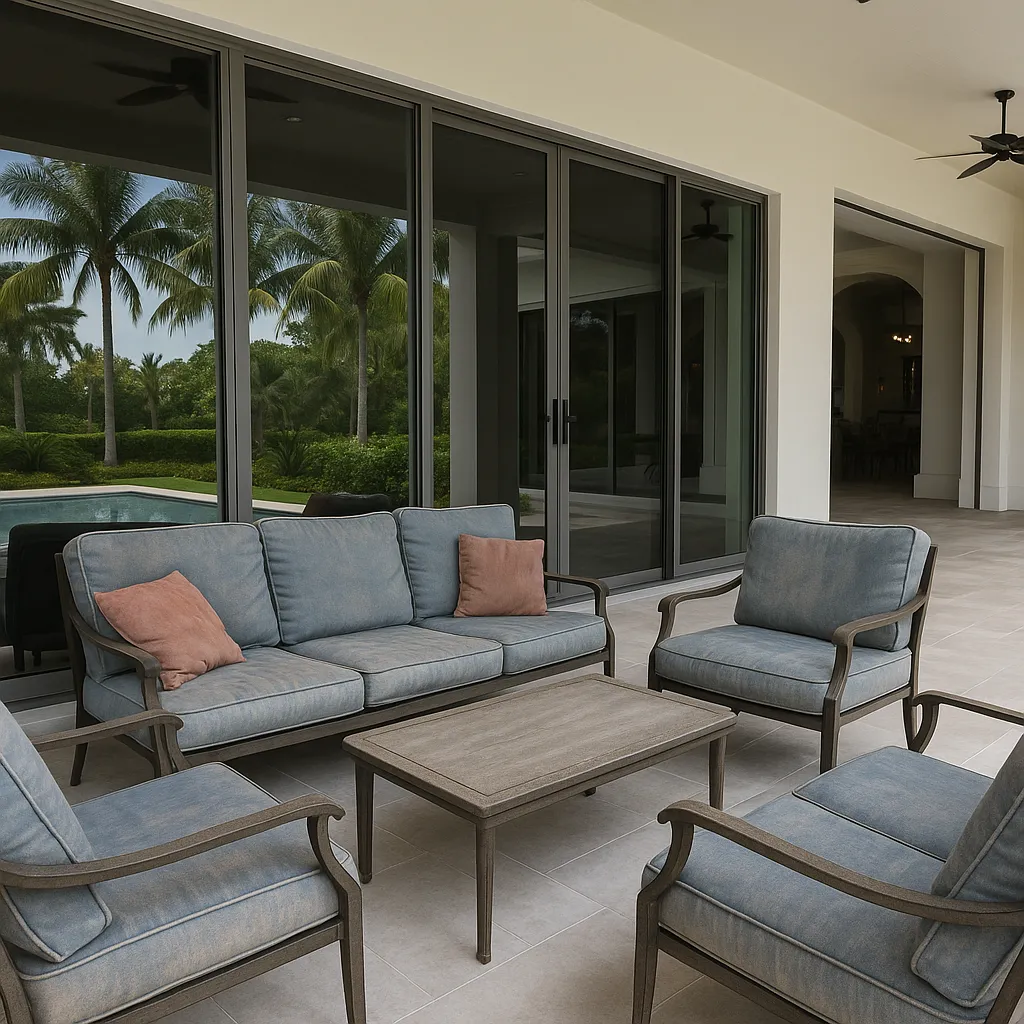
The Eighteen-Month Fade
How Do I Protect My Patio Furniture From The Fade?
Showroom floors have excellent lighting.
That's the first thing you notice when shopping for outdoor furniture. Everything looks vibrant. Rich. Those deep navy cushions practically glow under the LED spots. The salesperson smiles warmly and assures you these pieces are built for Florida.
"UV-resistant fabric. Marine-grade materials. You'll get a decade out of this set, easy."
You write the check. Thirty-eight hundred dollars.
Eighteen months later, you're staring at those same cushions wondering what happened.
The navy isn't navy anymore. It's this washed-out grayish-blue that reminds you of old denim someone forgot in the sun. The terracotta looks like dusty pink. The powder-coated aluminum—guaranteed against corrosion—has white blooms spreading at every joint like some sort of industrial fungus.
You're researching replacement cushions because guests are coming next month and you're embarrassed.
Thirty-eight hundred dollars bought you eighteen months of decent-looking furniture.
This is South Florida.
The UV Reality Nobody Mentions
Here's what the furniture stores won't tell you. Can't tell you, really, because then you'd never buy anything.
South Florida maintains extreme UV levels—we're talking index ratings of nine to eleven—from April straight through September. Even winter months hover in the "very high" range. Six to eight on the index.
Most of the country deals with intense UV for maybe three, four months. Summer only.
We get it nearly year-round.
Your furniture isn't just sitting outside. It's being bombarded. Constantly. By radiation strong enough to break down protective coatings, fade dyes, weaken fibers, and generally accelerate every form of deterioration known to outdoor materials.
Add humidity. Seventy to eighty percent, day after day. UV breaks down the protective layers. Humidity penetrates. You get mildew in cushion cores. Accelerated color fading. Fabric fibers that weaken and tear.
Then there's the rain-sun-rain cycle. Morning sun. Afternoon thunderstorm. Evening sun. Repeat daily from June through September.
Water gets into UV-damaged fabrics. Mold grows. Everything stays damp just long enough to cause problems, then bakes dry again, then gets wet again.
It's brutal.
Even "marine-grade" materials can't keep up forever.
The Replacement Treadmill
Let's talk about what this actually costs.
Your initial investment: Sixty-eight hundred dollars. Mid-range six-person dining set, lounge furniture, side tables, décor.
Two years in, you're replacing cushions. Twelve hundred dollars.
Year five, you need everything. The furniture itself has deteriorated beyond salvaging. Another sixty-eight hundred.
Year seven, cushions again. Twelve hundred more.
Year ten, full replacement. Sixty-eight hundred.
Add it up. Over ten years, you're spending twenty-two thousand, eight hundred dollars just to maintain your outdoor space.
And that doesn't count your time. The hours spent shopping. Researching materials. Comparing fabrics. Arranging delivery. Disposing of the old furniture.
It doesn't count the embarrassment. That feeling when friends visit and your once-beautiful patio looks neglected.
It doesn't count the resignation. The slow acceptance that "outdoor furniture just doesn't last in Florida."
Except it can. If you protect it.
When "UV-Resistant" Isn't Enough
The term sounds reassuring. UV-resistant fabric. Like it's been inoculated against sun damage.
But resistant isn't the same as proof.
UV-resistant means the fabric has been treated with protective coatings. These coatings slow down sun damage. They don't prevent it. In South Florida's extreme conditions, even the best outdoor fabrics will fade within eighteen to thirty-six months. The protective coating breaks down. The fabric underneath starts deteriorating.
Most homeowners end up on this exhausting cycle:
Buy expensive outdoor-rated furniture. Watch it deteriorate faster than expected. Research better materials. Replace cushions or entire sets. Repeat every two to five years.
There's a better approach.
The Protection Investment
Richard and Linda live in Delray Beach.
Twenty-twenty, they spent fifty-two hundred on high-end outdoor furniture. Sunbrella cushions—the gold standard. Everything the internet recommended for Florida living.
Twenty-twenty-two, the cushions were noticeably faded. They prepared to order replacements. Fourteen hundred dollars.
Then their neighbor showed them something.
MagnaTrack motorized screens that could deploy during peak sun hours. Block UV while maintaining view and airflow. Retract completely when you didn't need them.
They contacted Florida Living Outdoor and did the math. Cushion replacement every few years versus one installation that would protect everything.
Three years later, their original cushions still look nearly new.
Navy blue is still navy blue. No mildew. No fading patterns. No emergency covering before storms.
How Solar Screens Actually Work
Think of them as sunscreen for your patio.
Quality solar screens—like those from MagnaTrack and Fenetex—block eighty to ninety-five percent of UV radiation. You can still see through them. Air still flows. But the destructive rays—the ones breaking down your furniture—get stopped.
The convenience matters too. Morning, screens retracted. Full open-air experience. Ten AM to four PM, screens deployed. One button press. UV blocked. Furniture protected.
Late afternoon, retract them again. Enjoy the evening breeze.
Many systems from Florida Living Outdoor integrate with weather sensors. Your screens can deploy automatically when UV levels spike. When rain approaches. When you're not even home.
Smart protection that requires zero effort.
The Real Math
Let's compare actual costs:
Option A: Keep Replacing Furniture
Year zero: $6,800 (initial purchase)
Year two: $1,200 (cushion replacement)
Year five: $6,800 (full replacement)
Year seven: $1,200 (cushions)
Year ten: $6,800 (full replacement)
Ten-year total: $22,800
Option B: Protect What You Have
Year zero: $6,800 (furniture) + $8,500 (motorized screens)
Years two through ten: Minimal maintenance (cushion cleaning)
Ten-year total: $15,300
You save seventy-five hundred dollars. Minimum.
And your furniture actually looks good the entire time. No constant shopping. No storage headaches. No apologizing to guests about faded cushions.
What Else Gets Protected
Motorized solar screens don't just save cushions.
Your flooring lasts longer. Tile stays cooler. Wood doesn't fade or warp. Outdoor rugs last three to five times longer.
Your plants thrive. Delicate tropicals get protection from intense midday sun. Reduced watering needs. No more crispy, burned leaves.
Your comfort improves. Fifteen to twenty degrees cooler in the screened area. Reduced glare for outdoor dining. Lower AC costs for adjacent rooms.
Your privacy increases. Solar screens provide daytime privacy while you maintain outward visibility. No more fishbowl feeling.
What Homeowners Say
Michael from Boca: "I spent twenty-four hundred on Sunbrella cushions twice before I got screens. I could've paid for the screens with what I wasted on replacements."
Jennifer in Fort Lauderdale: "The UV protection is great, but honestly? The temperature difference shocked me. Our patio is twenty degrees cooler on summer afternoons. We actually use it now."
David and Carol, West Palm Beach: "Same outdoor furniture for six years. Our neighbor replaced theirs twice. The screens paid for themselves."
The Questions People Ask
Will screens make my patio dark?
No. Quality solar screens block UV while maintaining ninety percent visibility. You'll notice slight shading—which actually feels more comfortable—but it won't feel enclosed or dim.
Do I keep them closed all the time?
That's the beauty of motorized screens. Deploy them when UV is intense. Retract them for full open-air living. Total control. Your choice.
What about rain and storms?
The screens provide additional protection during storms. They're primarily designed for sun and UV protection, but hurricane-rated options exist for serious wind protection.
Can I still feel the breeze?
Yes. Solar screens allow airflow while blocking UV. You maintain ventilation and comfort.
Your Furniture Deserves Better
You invested in quality outdoor furniture because you wanted to enjoy South Florida's lifestyle.
You shouldn't have to replace it every few years because of sun damage.
One installation. One button. Decades of protection.
Stop replacing. Start protecting.
Ready to protect your investment? Contact Florida Living Outdoor to schedule your free consultation. We'll show you exactly how much you could save with MagnaTrack or Fenetex motorized screen systems.
Serving Palm Beach, Broward, and Miami-Dade Counties
